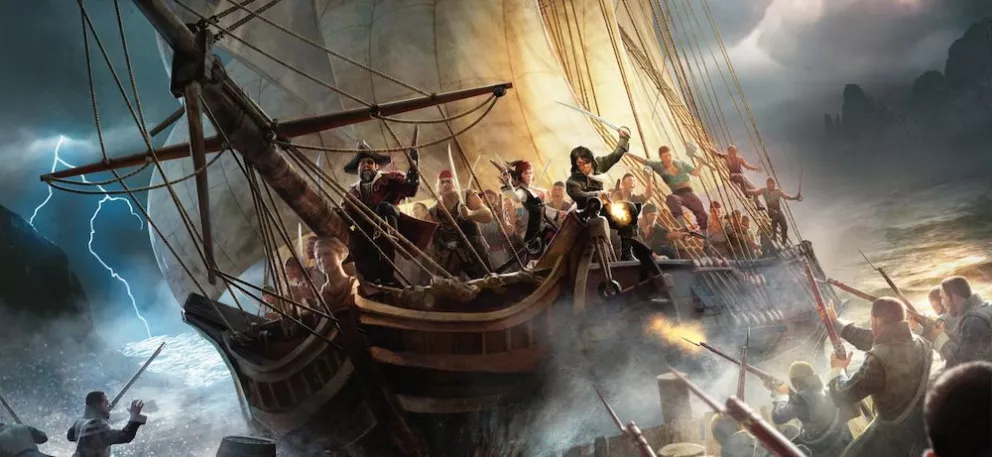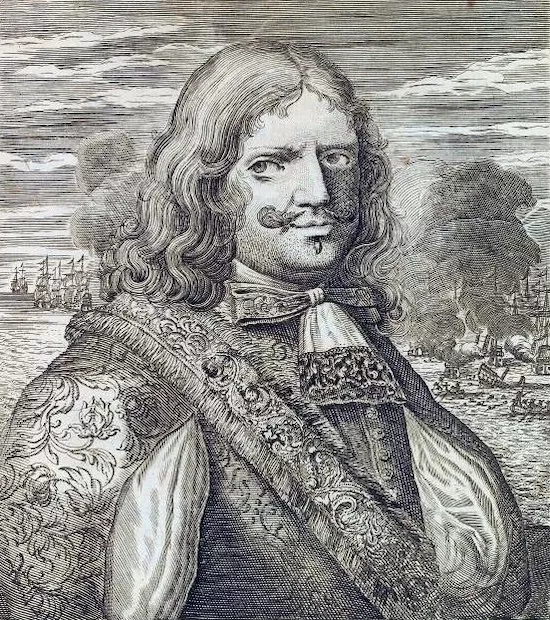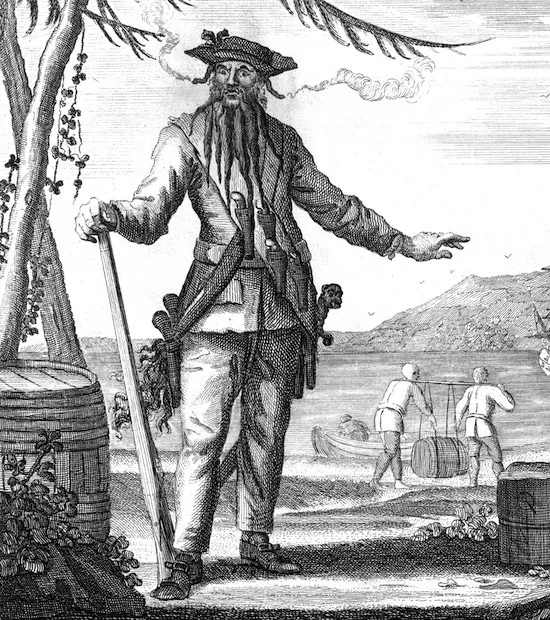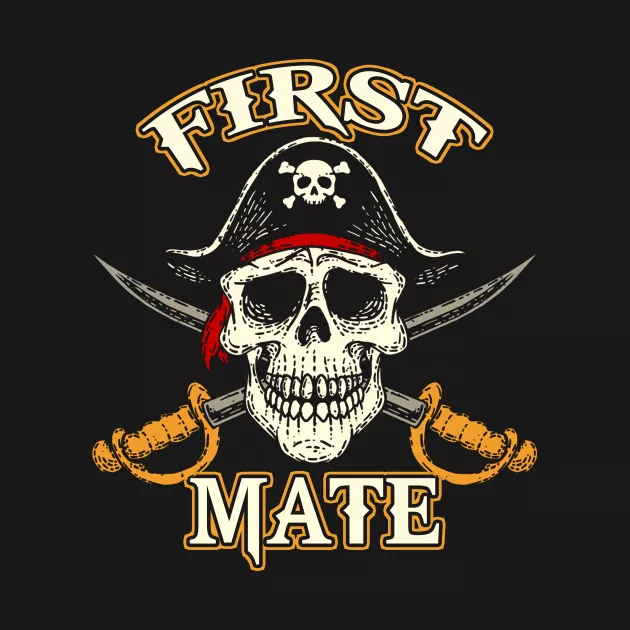Don't see a crew member listed here? Check out the Lexicon.

The Captain
One thing for sure about pirates is they didn't like authority. The Navy ships of the various countries were usually commanded by the privileged class, not necessarily because of any inherent skill but just because that was the way it was done. Sailor in the regular navy were often treated miserably by their Captains. Pirates would have nothing to with this.
Contrary to the book Treasure Island[1], most Captains didn't command by an iron fist, they commanded because of skill, daring and the ability to win prize and booty. In some cases pirate ship elected its Captain through a vote. If the Captain fell in disfavour the crew were just a quick as quick to maroon their captain, or throw him overboard, or perhaps if he were lucky they would just let him off at the nearest port.
But it is safe to assume that if a Captain had a bad cruise with little to show for it and the end of it, it would be difficult for him to raise a new crew in the future.
Important matters such as where the ship might sail, or rather or not to put into port, or if a certain ship should be engaged and so on, were quite often not up to the Captain. These pressing details were decided by vote, with the majority ruling. If the Captain were to go against the vote, then he too would be in violation of the Articles of Piracy, and would most likely step down from command and new leader would be chosen.
Of course on other ships, simply through his skill and charisma, a pirate captain would command and lead with his voice being the ultimate authority. While it is true that after mutinies crews would sometimes vote ona new captain before going pirate, it was usually the leader of the mutiny that got the vote. It is also true that, especially among some of the smaller pirate vessels, that the pirate crew was led by a natural leader and his close mates. In such a case, the pirate crew may work more like a family or clan than the much touted democracy.
Famous Captains
Some famous captains from the pirate history are listed below.


Quartermaster
The Quartermaster, depending on the circumstances and the pirate ship was the second in command. His main purpose was to distribute things. He distributed rations, powder, work, prize and punishment.
Pirate didn't trust authority and therefore saw no reason to let all the power of a ship rest on one man. Therefore, they split the power between the Captain (who led and navigated the ship in battle) and the Quartermaster (who usually led the way on any boarding party and kept custody of all prize or booty). The Quartermaster rank's responsibility was also to determine what prize was worth taking.
As expected all gold, silver, or coin was taken, but beyond that, it was the quartermaster who decided what else was worth taking. He made his decisions based on time on how much room the ship had. If the ship was already cramped, spices and exotic materials may be burned rather that stolen.
The quartermaster would also watch over the treasure until it was divided among the crew. It was also the quartermaster who did the dividing, with the crew's supervision. There was rarely a dispute about how the loot was divided, however.
The quartermaster also settled individual quarrels and if need be, acted as a witness to any duels, to ensure that duels were fair and just. Finally, on some ships, except when in battle the quartermaster might actually hold a position above the captain, especially in matters of punishment and rations.
Despite all the activity of the quartermaster rank, pirate captains would still pick their other officers such as first and second mate, often creating a complex chain of command on a pirate ship.
Of course this was not always the case. In many cases, a pirate captain was the ultimate law and there was no quartermaster or the quartermaster and captain worked as if captain and first mate. Much of the discussion of quartermasters is found in the General History of Pirates[2] and it would be foolish to think all pirate crews had a division of power as it described in that book.
First Mate

On most ships, the First Mate is the officer who ranks just below the Captain of the ship and takes over in the event that the Captain can no longer perform his duties. Unfortunately this is not the case on a pirate ship. The first mate role on a pirate ship is the man the pirate picks as his second in command. In the even the pirate is killed the job falls to the quartermaster. Ships also had second, third, even forth mates creating a chain of command.
Boatswain (bos ´n)
Among the crews were several skilled seamen who kept the ship afloat or kept the crew in place. The Bos'n was one of them. Originally, on board a sailing ship such as a man-of-war or a galleon, the boatswain was in charge of a ship's anchors, cordage, colors, deck crew and the ship's boats, and would also be in charge of the rigging while the ship was in dock. The bos'n is often a petty officer. On a sailing ship he might be the thyroid or forth mate. within a pirate crew, if it were large a Bos'n would be right under the quartermaster. On a smaller ship the quartermaster would handle the jobs of the bos'n.
Cabin Boy
The cabin boy is typically a young boy of privileged birth who is sent to sea to learn the maritime trade. Typically the cabin boy waits upon the officers of the ship. In some instances he may act as the Captain's servant. The cabin boy will run messages and errands for the officers, prepare their uniforms, perhaps even fetches their dinner. Because he is an apprentice of sorts, he is also expected to learn all aspects of the maritime trade. The cabin boy works long hard hours. Even on pirate ships, the captain might employ a young energetic fellow as a cabin boy.
Carpenter
A ship's carpenter was the man who kept the ship afloat, making necessary repairs, filling holes if need be, and so on. Carpentry was an extremely useful skill onboard ship and good carpenters were highly valued.
Gunner
Gunners were skilled men who aimed the guns on a ship. In some instances a master gunner would give orders to other gunners on how to set their guns during a broadside. It took years of practice to become a good gunner.
Master
The term used to describe a leader of certain section. Thus the master gunner is the person in charge of the guns (artillery, now pistols), the Master Rigger would be in charge of fixing the ships rigging, a Master carpenter, would be the top carpenter. Under these "masters" would be a series of mates. Thus you might have a gunners mate and gunners second mate and so on.
Pilot
The man at the helm. The helmsman. The pilot was the man who steered the ship. Typically one man would be the master pilot who would work with the navigator and captain to pilot the ship over the water. The pilot needed to know such aspects as the ship's draught (how deep she sat in the water) how wide the ship was and how sharply she could turn. In shallow waters, the crew would take soundings (checking the depth of the water) and it would be up to the pilot to either steer the ship or sometimes stand at the bow and relay orders back to the man at the helm which way to steer the ship. Quite often, in the movies you see the captain of the ship giving the orders but in real life the captain would rely on the pilot of the ship to do such a task. In some cases a crew man might be given the task of acting as a pilot for a portion of a voyage because they were more familiar with sand banks, hidden shoals, and rough currents in an that area
Powder Monkey
Powder Monkey was a British naval term used to describe the young boys who made up the gun crews. The term dates from the 1600s. Many powder monkeys were probably pressed into service, being kidnapped by press gangs and forced to serve aboard ship. Often the powder monkeys were young lads no more than eleven to thirteen years old. They mainly assisted the gun crews and learned most of the ships basics but were paid little (if anything), treated poorly, and were expendable. If they managed to live a few years, they might eventually make it to a position of more importance on the ship. Often, due to their harsh life, powder monkeys were quick to sign articles and desert a ship. On a pirate ship, new comers would serve the function of powder monkeys.
Sea Artist
A sea artists is not someone who paints seascapes. Typically, the term referred to the ship's navigator. The sea artist was expert at reading and correcting charts, using navigational tools such as the cross-staff, backstaff, quadrant, and sextant (depending on time period). They were also expert at use dead reckoning methods for determining longitude. Some were also capable of determining longitude using lunar observations (taking lunars). The sea artist was also an expert at reading the ocean, able to tell shallows and hidden reefs from deep waters and able to determine if storms were coming. Possessing such knowledge often would make a person the second mate if he were not already the first mate or captain.
On a more broad term, the sea artists was anyone who could maneuver ships over great distances with little or no difficulty, an expert seaman.
Striker
Often overlooked, the Striker was a native of the West Indies, typically from Darien or the Mosquito Coast. They were expert hunters who:
- trapped sea turtles and manatees;
- fished for sharks and other large fish;
- also hunted wild game when the the crew came ashore.
Their knowledge of local plants aided in collecting edible fruits and vegetables as well as medicinal plants and herbs.Their expert ability at hunting and fishing earned them a spot among the crew, Their hatred of Spain assured their loyalty and ferocity in battle. They were not kept aboard for the seaman ship, their job was to catch fish and kill Spaniards.
Surgeon
For a more detailed account, see the Pirate Medicine. Surgeons were highly valued among pirates and when pirates captured ships they would often press surgeons into service. A surgeon was typically the only person kept on board who was not required to sign articles. Depending on the nature of the crew some surgeons were paid even if they refused to sign on.
If a surgeon wasn't handy, then the crew would often elect someone with an inkling of knowledge to act as surgeon. On at least one account, the carpenter was elected the ship's surgeon, because the carpenter had the necessary tools needed to amputate limbs and knew how to cut quickly. At other times a cook might also be employed but cooks were normally considered less skillful at cutting than carpenters. Cooks weren't butchers and had little training. Typically they were crew members assigned to work the galley who managed to make edible food.
Watch video about Pirate hierarchy
Sources
- "Treasure Island" (1883) by Robert Louis Stevenson, ISBN: 978-4909069023
- "A General History of the Robberies and Murders of the most notorious Pyrates" (1724) by Captain Charles Johnson, ISBN: 978-1497385795

The only author and editor of all pages on the site. Most of what I write about is based on years of book reading on the topic. My first web page was published back in 1994.